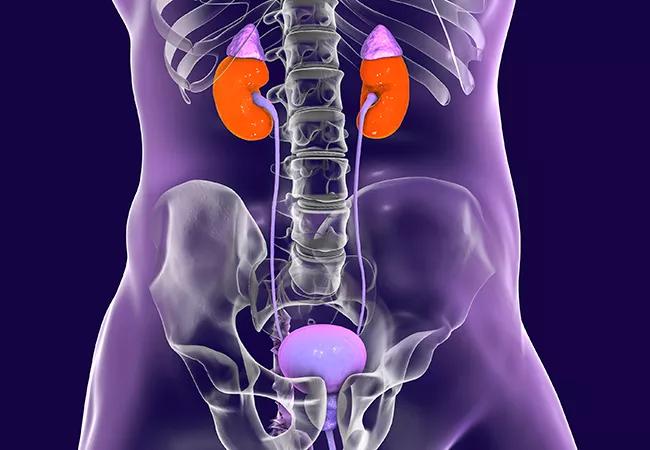New care path supports obstetric patients with bladder dysfunction

In 2021, Cleveland Clinic introduced a new care path for postpartum bladder management and updated order sets to align with the protocol. Nurses were an integral part of the multidisciplinary team that developed and implemented the best practices.
Advertisement
Cleveland Clinic is a non-profit academic medical center. Advertising on our site helps support our mission. We do not endorse non-Cleveland Clinic products or services. Policy
Postpartum voiding dysfunction is common after obstetric delivery, and it can lead to postpartum urinary retention (PPUR) – residual bladder volume after voiding of 150 ML or an inability to void six hours after delivery. The goal of the care path is to prevent PPUR, which, if left untreated, can have long-term damaging effects on the bladder.
“New mothers already have enough to deal with. They have newborn, they are breastfeeding, and they might have other children,” says Angela Washer, APRN-CNP, who serves as a Perinatal Clinical Nurse Specialist at Cleveland Clinic Fairview Hospital. “Our goal is to help prevent avoidable complications so our patients can focus on their babies.”
Work on the postpartum bladder management care path began when Heather DiCioccio, DNP, RNC-MNN, C-ONQS and nursing colleagues at Cleveland Clinic Hillcrest Hospital reviewed the literature for best practices. The review supported measuring and recording a patient’s first three voids after delivery or catheter removal. It also recommended further evaluation if a patient can’t void six hours after delivery or catheter removal or shows signs of urinary retention.
DiCioccio, who was a mother/baby nursing professional development specialist at the time, shared the information with physician leadership for the obstetrics service line. One of the physicians mentioned that a urogynecologist fellow at Cleveland Clinic was studying postpartum bladder management because she had cared for several patients in the outpatient setting with PPUR.
Advertisement
Now a nurse manager in the Family Birth Place and High-Risk Obstetrics at Fairview Hospital, DiCioccio invited the urogynecologist fellow and Washer to join the team and help revamp and standardize care. Other team members included a nursing director, nurse managers, OB physician leaders and a representative from the quality department.
While preliminary work began to create a care path and revise postpartum order sets, DiCioccio and Washer received approval to implement changes to practice.
“Clinical nurses began to measure and document the first three voids following a vaginal or C-section delivery to make sure it’s a good quantity,” she says. “This was a simple change we could make while the team was looking at the big picture.”
If urine quantities are low or the patient is unable to void, nurses perform a bladder scan using a scanner shared with the labor unit. There was a noticeable uptick in the need for bladder scans after caregivers began measuring the first three voids.
“Once we began to focus on this, we realized the extent of postpartum bladder dysfunction,” says Washer.
The combination of the practice change and increased use of bladder scans led the nurses to conduct another literature review to address the postpartum bladder management protocol.
“There was conflicting information about when to use straight catheters and Foley catheters and for how long,” says DiCioccio.
This is where collaboration among the interdisciplinary team, including physicians, was invaluable. The group met routinely for nearly a year to discuss and develop an algorithm and care path to guide patient care.
Advertisement
“There was a lot of discussion on what kind of workflow would work best,” says DiCioccio. “We’re not going to measure intake and output the entire patient stay. That’s not necessary. But we needed to find a workable solution for the busy postpartum nurse and the recovering mother that still gives us the information we need.”
The resulting postpartum bladder management care path guide includes five sections:
In addition, the postpartum order sets were modified to align with the bladder management protocol. Clinical nurses were informed of the changes during huddles and rounding, as well as through weekly updates from nurse managers.
The new care path benefits patients and the healthcare system.
“It’s a simple way to prevent problems that become complex and costly in the outpatient setting once a patient has been discharged,” says Washer.
From a broader perspective, the process to re-examine and revamp protocols – which was led by nurses – highlights the value of nursing.
Advertisement
“Nursing innovation is just as important as physician innovation,” says Washer. “Practice changes that we make can have an enormously positive affect on patient outcomes.”
DiCioccio echoes this sentiment, encouraging nurses to “own your practice!”
Advertisement
Advertisement

Findings underscore the value of clinical monitoring in pregnant patients using SSRIs and SNRIs

Study explores role of single-dose drug in fostering the mother-infant dyad

Supporting birthing patients through newer tools and strategies

Multidisciplinary approach starts with early and regular screenings

Outcomes from a registry study reveal why closer monitoring may be warranted during the postpartum period

An unexpected health scare provides a potent reminder of what patients need most from their caregivers

Cleveland Clinic Abu Dhabi initiative reduces ICU admissions and strengthens caregiver collaboration

Veteran nurse blends compassion, cutting-edge transplant training and military tradition to elevate patient care